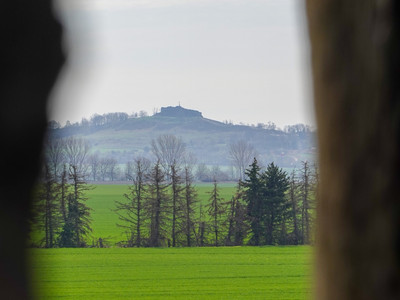Through the nature reserve near Ballenstedt.
Natura Tip 10 - Gegensteine and Schierberge near Ballenstedt
Short facts
- start: Castle Square Ballenstedt
- destination: Castle Square Ballenstedt
- easy
- 10,86 km
- 2 hours 50 minutes
- 260 m
- 193 m
- Loop tour
best season
Tour waypoints
Schloss Ballenstedt
Schlosstheater Ballenstedt
Sonderstempel Schloss Ballenstedt
Sonderstempel Roseburg
Tour-Dashboard
Pavings
- Street (8%)
- Asphalt Coating (23%)
- Crushed Rock (25%)
- Hiking Trail (30%)
- Path (14%)
Weather
General information
The start of our circular hike is Castle Square Ballenstedt. There are numerous parking spaces there. We leave the castle square heading north. You go down the Trift or alternatively through the castle park, then over the B 185 to the Felsenkellerweg bus stop of the Harz Transport Company. From there we follow the Felsenkellerweg. The path leads us along fruit trees further north. After a small climb, the Muschelkalk ridge of the Steinberge is reached. From here we can already see our first destination. These are the Gegensteine. Initially, we continue on the right before the next path branches north and we walk again under apple, cherry and plum trees. After crossing a hollow, a sign informs us about the Teufelsmauer trail, which we want to immediately follow.
But first, a few steps on the hollow way heading north are worthwhile. It cuts through the steeply tilted layers of chalk sandstone. Abandoned quarries testify to centuries of mining activity. People from the surrounding villages quarried sandstones for building. A few more steps and we see walls on the right and a steel door that closes the rock cellar. It is the beer cellar of a once very popular inn. In nearby, artificially created caves, mushroom cultivation was carried out. Afterwards, on the Teufelsmauer trail, after a short steep climb, we choose the upper right path. Along an orchard, it leads us to the ridge of the height to the Great Gegenstein. In the shade of the old sweet chestnut, we can rest before going up a narrow staircase cut into the rock in 1817.
On the sandstone ridge
At the top on the "Steinschiff" we are rewarded with a wonderful view from the Harz with Ramberg and Brocken to the EU bird sanctuary Hakel. A first cross on the Gegenstein was erected in 1863 in the year of death of Duke ALEXANDER CARL OF ANHALT-BERNBURG. This is commemorated by an art cast plaque cast at the Mägdesprung hut. In the rock niches, kestrel and pied wagtail breed. On the semi-dry grassland at the Great Gegenstein grow mullein, Carthusian pink, wild thyme and three gentian species. It continues westward. Heather broom, small hawkweed and gray scabious line the narrow path that leads us past the Small Gegenstein. In March and April a short detour into the small forest is recommended, from which a spring creek winds. Then countless snowflakes bloom there in Zehling. This is the regionally most important occurrence of this early bloomer. A few steps then go along the street westward. In the orchard, green woodpeckers and wrynecks breed. Opposite the small parking lot with the geopark information board, a little devil points the way to the Schierberge. It first leads uphill. At the top, after a few minutes' walk, more small sandstone formations are reached. Folk names gave them the names Mohrenkopf and Kutsche. The name Schierberge derives from the Old German word "schier", referring to the barren, low-yield soils. The south slopes were therefore traditionally grazed by sheep and goats and are characterized by semi-dry grassland and oak trees used as grazing trees. On the north slope, on the other hand, a primeval-like bedstraw-oak-hornbeam forest grows. Tall deciduous trees, including beech trees, provide nesting sites for birds of prey such as red kites and honey buzzards.
Muschelkalk ridge with Roseburg
From the shooting range, it goes left along the Eulenbach to Roseburg. Those who want to make a short detour to the Dicken Stein beforehand follow the gravel path towards Rieder. On the right, above an old quarry, the Dicken Stein rises as the westernmost rock formation of the eastern foothills of the Teufelsmauer. Back on the path, along the small stream winding around the roots of alders and willows, Roseburg is soon reached. The unpaved path is mowed only irregularly. In the morning or after rainfalls, this can lead to wet feet with light footwear. Over a small wooden bridge, we reach the wall enclosing the extensive park of Roseburg. Parallel to the wall, it goes a bit along the heavily trafficked L 242 to the only entrance to the scenic park, which offers us wonderful views.
On the castle hill, the Rudolphsburg was mentioned in writing in 964; nothing remains of it. The architect BERNHARD SEHRING (1855 – 1941), who designed, among others, the Theater des Westens in Berlin, built his dream castle here from 1907 with a landscape garden. He succeeded in an outstanding manner in combining elements of different artistic and historical periods in a park, which today is part of the statewide Gartenträume network. A park visit is therefore highly recommended! Afterwards, we choose the path on the ridge of the Steinberg towards Ballenstedt. On the grazed areas, we encounter plants of the eastern steppes, including field eryngo, golden thistle and cypress spurge. The savannah-like character of the landscape is given by the rock cherries with their sprawling crowns. At the Napoleon oaks, the Ballenstedt castle comes back into view.
Back to Ballenstedt
The Napoleon oaks were planted in 1813 in honour of soldiers returning from the Wars of Liberation. Characteristic for the north slope of the Steinberg are the orchards on both sides of the street "Am Zehling", which crosses the Steinberg. People early on knew about the special suitability of the slope for fruit growing. Late frosts during fruit blossom are rarer there because heavier cold air can quickly flow away. The variety of tall-stemmed apples, pears, cherries and plums in the nature reserve is large. Grazing within the orchards secures the sites of rare orchids. On the footpath along the street "Am Zehling", our route leads south to the Yellow House. The building with the small tower is a former customs station, built in the first half of the 19th century. Here we cross the B 185.
The now insignificant street "Alte Kreipe", where the Yellow House is located, was once an important trade route. We follow it to the Fürstenweg junction, an avenue lined with old winter lindens. Through the gate (stamp station no. 181 of the Harz Hiking Badge), we go into the castle park. The park was largely shaped by the Prussian landscape gardener PETER JOSEPH LENNÉ (1789 – 1866), according to whose designs, among others, the Tiergarten Berlin and several parks around Potsdam were designed. We look at the Golden Lion and stroll from there to the castle mill. Its waterwheel was powered by water diverted from the Kleine Sieberstein pond to the castle pond. Where an avenue of old winter lindens leads directly into the Amtmannstal and thus into the Natura 2000 area Burgesroth and deciduous forests near Ballenstedt (NATURA Tip 6), we leave the castle park. Passing the stable, the starting point of our circular hike is reached.
Many parking options at the supermarkets opposite the castle.
Tourist Information Ballenstedt
Anhaltiner Platz 7
06493 Ballenstedt
Tel: 039483 263
kontakt@ballenstedt-information.de
www.ballenstedt.de


